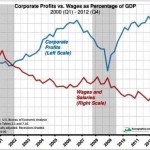The Middle Class — Strangled by Corporate Cost Cutting
March 11th, 2015
Last Friday’s employment figures sounded like good news. Total employment increased by 295,000 during February, and the U.S. unemployment rate declined to 5.5%. But there’s another side to the employment story, and it has to do with middle-class workers’ wages.
During the Great Recession of 2008 and in the several years following, many corporations — large and small, public and private — found it necessary to pare their employment costs through layoffs, as well as by cutting benefits to their remaining workforce. For some companies, the measures taken were essential to survive; for others, it helped to alleviate significant declines in profits. That’s the real world of business.
The cost-cutting measures included slashing or eliminating bonuses. I’m not referring to C-suite bonuses that run in the seven figures, but the small ones — the $500, $1000 and maybe $2,500 given to the rank and file employees as a goodwill gesture.
Another money-saving tactic utilized during that period was to reduce, or even do away with, the corporate match for employees’ retirement plans. That “free” return on employees’ 401(k) plans was a valuable asset in building a nest egg for later years.
Health care costs also came under sharp scrutiny. Companies were able to negotiate lower premiums with insurers by raising deductibles and co-pays for employees. In many cases, both the employer and the insurer benefited from reduced costs, while the employee was saddled with higher out-of-pocket expenses.
Now, nearly eight years later, the economy has improved significantly. GDP is at an all-time high, as are corporate profits. That should be great news for workers — solid, profitable growth ought to imply that salaries are increasing, previously cut benefits have been restored and bonuses are once again being paid.
But in fact, it seems that many companies have conveniently forgotten the fact that they took benefits away from their employees when times were tough.
From 2000 through 2013, (a period that includes both a robust economy and the Great Recession) corporate profits increased by 132% (a 6.7% annualized growth rate), while wages and salaries grew by only 47%, or the equivalent of 3% per year. The graph below shows how profits (blue line) are becoming a larger share of the economic pie at the expense of wages (red line).

Source: U.S. Bureau of Economic Analysis
To some extent, the divergence in those two lines is a function of cheap capital replacing more expensive labor. But importantly, it is also the result of productivity gains, and one of the advantages of productivity is that it allows employers to increase wages and benefits without an inflationary impact. Unfortunately, that doesn’t seem to be happening to any major degree in the U.S.
With a mere 3% annual increase in salaries and wages barely outpacing inflation, together with rising out-of-pocket expenditures for health care, it is no wonder that the middle class feels trapped.
Good corporate stewardship entails dealing fairly with all stakeholders — owners, employees, customers and vendors. Many companies in this country embrace that responsibility; however, many more tend to act as though the only stakeholder that matters is the owner (private or public).
Now is the time for companies that are thriving to restore to their employees the benefits that were curtailed or eliminated during the recession. The goodwill created among the workforce should be reward enough, but we all know that the reason for the anemic recovery from the Great Recession has been weak consumer spending. A robust expansion depends on strong consumer expenditures. We need higher real wages to take the economy to the next level.
 Patricia Chadwick
Patricia Chadwick (0 new)
(0 new)